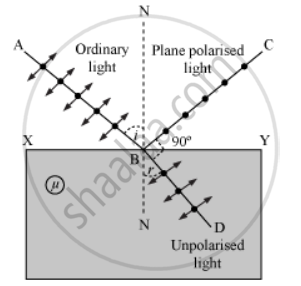Advertisements
Advertisements
प्रश्न
Show using a proper diagram how unpolarised light can be linearly polarised by reflection from a transparent glass surface.
उत्तर
Polarisation by Reflection

An ordinary beam of light, on reflection from a transparent medium, becomes partially polarised. The degree of polarisation increases as the angle of incidence is increased. At a particular value of the angle of incidence, the reflected beam becomes completely polarised. This angle of incidence is called the polarising angle (p).
APPEARS IN
संबंधित प्रश्न
With the help of neat diagram, explain how non-polar dielectric material is polarised in external electric field of increasing intensity. Define polarisation in dielectrics.
What dose a polaroid consist of?
A beam of unpolarised light is incident on a glass-air interface. Show, using a suitable ray diagram, that light reflected from the interface is totally polarised, when μ = tan iB, where μ is the refractive index of glass with respect to air and iB is the Brewster's angle.
Using the phenomenon of polarisation, show how the transverse nature of light can be demonstrated.
When a low flying aircraft passes overhead, we sometimes notice a slight shaking of the picture on our TV screen. Suggest a possible explanation.
Unpolarised light is incident on a polaroid. How would the intensity of transmitted light change when the polaroid is rotated?
What is a analyser?
How is polarisation of light obtained by scattering of light?
A plane mirror produces a magnification of
Polarisation of light is the only phenomenon that establishes ______.
